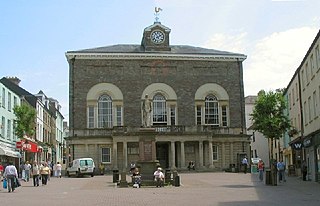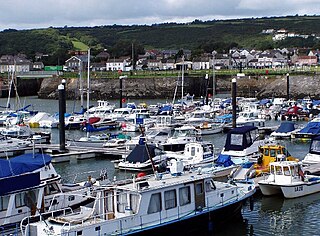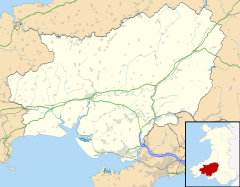
Carmarthenshire is a county in the south-west of Wales. The three largest towns are Llanelli, Carmarthen and Ammanford. Carmarthen is the county town and administrative centre. The county is known as the "Garden of Wales" and is also home to the National Botanic Garden of Wales.

Kidwelly is a town and community in Carmarthenshire, southwest Wales, approximately 7 miles (11 km) northwest of the most populous town in the county, Llanelli. In the 2001 census the community of Kidwelly returned a population of 3,289, increasing to 3,523 at the 2011 Census.

Carmarthen Bay is an inlet of the South Wales coast, including notable beaches such as Pendine Sands and Cefn Sidan sands. Carmarthen Bay is partially within the Pembrokeshire Coast National Park. The Joint Nature Conservation Committee list Carmarthen Bay and Estuaries as a Special Area of Conservation.

Cefn Sidan is a long sandy beach with dunes, which form the outer edge of the Pembrey Burrows between Burry Port and Kidwelly, facing southwestwards over Carmarthen Bay in South Wales. Cefn Sidan beach is backed by dunes, salt marshes, Pembrey Forest and the Pembrey Country Park.

Pembrey is a village in Carmarthenshire, Wales, situated between Burry Port and Kidwelly, overlooking Carmarthen Bay, with a population of about 2,154 in 2011. The electoral ward having a population of 4,301. It is in the community of Pembrey and Burry Port Town.
The Burry Port and Gwendraeth Valley Railway (BP&GVR) was a mineral railway company that constructed a railway line in Carmarthenshire, Wales, by conversion of a canal, to connect collieries and limestone pits to the sea at Kidwelly. It extended its network to include Burry Port, Trimsaran and a brickworks at Pwll, later extending to Sandy near Llanelli. For a time the company worked the separate Gwendraeth Valleys Railway. The BP&GVR was notable because of the very low height of some overbridges, a legacy of the canal conversion.

The River Gwendraeth is a river in Carmarthenshire in West Wales.

Pontyberem is a village and community situated in the Gwendraeth Valley halfway between Carmarthen and Llanelli in Carmarthenshire, Wales. As of the 2001 Census, the population was recorded as 2,829, reducing to 2,768 at the 2011 Census.
Trimsaran is a community and former mining village which lies on the B4308 between Llanelli and Kidwelly, in the Welsh county of Carmarthenshire.
Cefneithin is a village and community in Carmarthenshire, Wales, in the Carmarthenshire coalfield area. It lies just off the A48 road, 7 miles north west of Ammanford and 9 miles north of Llanelli. Its nearby community villages include Cross Hands, Drefach, Cwmmawr, Foelgastell and Gorslas. The Gwendraeth Fawr river flows nearby and its source is at Llyn Llech Owain, just north of the village. Cefneithin has a chapel (Tabernacl), a village hall, a primary school, and a secondary school. The latter, Ysgol Maes y Gwendraeth, was re-opened in 2016 after an extensive renovation and an £18.4m investment; it has 1,000 pupils, of which 157 in sixth form, and resources for children with additional learning needs. Prior to 2016 when the school was called Ysgol Gyfun Maes Yr Yrfa, some of its famous pupils include Nigel Owens, Jonathan Edwards, TV presenter Alex Jones and British and Irish Lion rugby player, Dwayne Peel.
Pontyates is a village straddling two communities situated in the Gwendraeth Valley halfway between Carmarthen and Llanelli in Carmarthenshire, West Wales. the population in 2011 was 1,449.

The Kidwelly and Llanelly Canal was a canal and tramroad system in Carmarthenshire, Wales, built to carry anthracite coal to the coast for onward transportation by coastal ships. It began life as Kymer's Canal in 1766, which linked pits at Pwll y Llygod to a dock near Kidwelly. Access to the dock gradually became more difficult as the estuary silted up, and an extension to Llanelli was authorised in 1812. Progress was slow, and the new canal was linked to a harbour at Pembrey built by Thomas Gaunt in the 1820s, until the company's own harbour at Burry Port was completed in 1832. Tramways served a number of collieries to the east of Burry Port.
Pembrey and Burry Port Town is a community located in Carmarthenshire, Wales including the town of Burry Port and the village of Pembrey. The community population taken at the 2011 census was 8,547.

Court Farm in Pembrey, Carmarthenshire, Wales, is an ancient and formerly imposing manor house which is now an overgrown ruin, but structurally sound, and capable of repair and restoration. It consists of three buildings: the farmhouse, a complex two-storey house of approximately 99 square metres; an adjacent barn; and a later cowshed.

Burry Port Lighthouse is a lighthouse in Burry Port.
Cwmmawr for Tumble railway station,Cwm Mawr railway station or Cwmmawr railway station was opened in 1913 to timetabled passenger services. It continued to serve the inhabitants of the Cwmmawr area and hinterland between 1913 and 1953; it was one of several basic stations opened on the Burry Port and Gwendraeth Valley Railway in Carmarthenshire, Wales.
Pembrey railway station or Pembrey Halt railway station served the village of Pen-bre or Pembrey. It continued to serve the inhabitants of the area between 1909 and 1953 and was one of several basic halts opened on the Burry Port and Gwendraeth Valley Railway in Carmarthenshire, Wales.
Burry Port railway station served the town of Burry Port. It continued to serve the inhabitants of the area near Llanelli between 1909 and 1953 and was one of several basic halts opened on the Burry Port and Gwendraeth Valley Railway in Carmarthenshire, Wales.

Burry Port Harbour is a former industrial harbour which mainly served the coal industry, on the Loughor estuary. It is now converted into a marina. The town of Burry Port grew around the harbour.


















